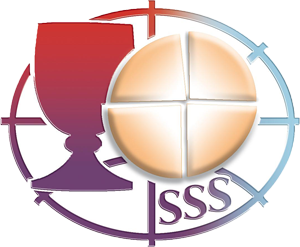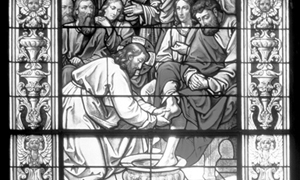Liturgical Space and Artificial Intelligence*
Tino Grisi
Tino Grisi, Ph.D., is founder of the Church for the Future Design Studio at the Politecnico di Milano (Milan, Italy), where he also lectures. Professor Grisi’s doctoral dissertation for the University of Bologna (2013) examined the ecclesiastical projects of the German modernist architect, Emil Steffann (1899-1968). For the past two decades, he has been involved in the design and adaptation of sacred spaces, most recently with the help of A.I. imaging technologies of the kind he writes about here. He is a much sought- after speaker and prolific author. Among his more recent publications are Architettura Liturgica. Un Dizionari essenziale (2019) and, with Andrea Marcuccetti, Spiritual A.I. Worldwide (2024). Various examples of Dr. Grisi’s A.I.-assisted work may be found at his website: tinogrisiarchitetto.com.
*English translation provided by the author.
Sacred Architecture’s Attachment to Habit
Spaces for sacred liturgy often suffer from the “additive” approach to expression favored by their designers. We treat settings for the Church’s highest form of worship in the way that brides on their wedding days entrust their fortunes to wearing, as we say, “something old, something new, something borrowed, something blue.” The “something given” that also contributes to their appearance is what we might call “tradition.” For architects and others responsible for imagining what sacred spaces might look like today, the “given” amounts to practices of design and construction applied as a matter of habit.
On occasion during his pontificate, Pope Benedict XVI (1927–2022) addressed an issue of great relevance to church designers: How do we express theology and faith in an architectural language of our own time? [1] The question Benedict raises is a good one and causes us to reflect on how ecclesiastical architecture attracts and facilitates religious practice in its anxious pursuit of appearing “correct” reflects a traditional conception of God as a physical presence manifested in a particular place. I argue that moving beyond this hinges on imagining God not as being limited to physical settings, including those characterized by features convention defines as “sacred.” Modern society and theology have both evolved in their conceptions of God, which has opened ways of thinking of the divine as an all-pervading, spiritual presence not limited to a single location or architectural environment.
Modern society and theology have both evolved in their conceptions of God, which has opened ways of thinking of the divine as an all-pervading, spiritual presence not limited to a single location or architectural environment.
There is, in fact, a fundamental misunderstanding in which religious art and architecture often get lost in their search for an identity to propose to the faithful the belief that they possess a specific character separate from the turbulent and ongoing flow of contemporary expression in general. Often the pursuit of this separateness causes the Church’s artists and architects to lower their expectations and compromise on their results. The artist and Catholic priest, Herbert Falken (1932–2023) demonstrated to us, without hypocrisy, the ineffectiveness of this approach: “I don’t make Christian art, “he insisted. “What makes art art is not the Christian aspect, but the figure. Christian themes are painted by schoolchildren, too. When you say Christian art, you’re saying there’s a difference from art. If I want to paint my faith, it’s over—I don’t even need to begin. But if I’m doing something, and my faith resonates in the subconscious or in temporary reflection, then it’s the right thing to do, at least for me.” Falken clearly describes the danger we face when “we think we know what our faith looks like, what images it should appear in—while we may be losing the truly essential images, the authentic ones.” As a seeker of God, he claims the inadequacy of seeing art merely as a confirmation of a modified vocabulary of traditional Christian iconography.[2]

A.I.-Generated Image of Sacred Space
Tino Grisi (2025)
Reproduced with Permission
A.I. and the Breaking of Clichés
This unsettling and seemingly disarming invitation actually encourages us to consider compositional work for spirituality as a systematic development of visual imagination. The tool of artificial intelligence (A.I.) can then provide us with a different mode of depicting architectural spaces and structures thanks to its continuous generative capacity. If creatively directed, this moves its user beyond repeated, clichéd, and poorly conveyed references [to the past]—the very ones that have proven unable to build consensus around the modern idea of liturgical architecture. Using A.I. as a means of designing places for worship allows the architect to reveal a shifting, revelatory image of the spaces contained within them. They lack nothing but embody the very substance of the spiritual. A.I. can be used not only to depict what sacred spaces might look like to their prospective users but as tool of conceptualization for architects eager to imagine how they will eventually function. In this it fosters for both the sort of contemplative imagination we associate with Saint Ignatius of Loyola (1491-1556), which drew heavily from the most novel and abstract of imagery.
Theologian Romano Guardini (1885–1968) long ago offered us a key to understanding space as a spiritual reference to God’s invisibility by suggesting that “the emptiness within it is itself an image.” No space, according to Guardini, even if it should be stripped of traditional iconography, is ever really “empty.” “[Space] is not a mere negation of figurativeness,” he added, “but its opposite pole,” and therefore a way by which one “perceives a mysterious absence.”[3] If religious architecture is to serve this mystery, its task must be to lead toward revelation, that is, a situation in which “the people and their Lord are found in the same shared space.”[4]
The painter, Barnett Newman (1905–1970), put forward similar ideas. “Instead of using outlines, instead of making shapes or setting off space,” he said of his work, “my drawing declares the space. Instead of working with the remnants of space, I work with the whole space.” [5] The idea of working with whole space guides Newman’s art. It does not focus on subjects or figures within the space but seeks to make space itself emerge as a fundamental element of his expression. The goal is to engage the viewer in a unique and immersive experience in which space itself becomes an expressive medium, communicating something deeper than traditional, plastic representation. In this sense, space “opens up to a place experience,” evokes the “feeling that space is here,” and acts “to deconstruct habitual certainties” about it—producing, as Guardini noted, “the unique appearance of a distance” that allows us to touch the depth of the invisible through the real.[6]
The legitimacy of this method of generating spiritual imagery can be found in the aesthetic theories of a giant of Catholic culture like Jacques Maritain (1882–1973), who spoke of humanity’s creative dimension as illuminating intellect, a spiritual unconscious, and a productive imagination. Art, Maritan believed, can act as a means of bringing forth and giving voice to the hidden spiritual dimension in our lives, allowing us to connect with our innermost selves and transcendent realities. For artists, the productive imagination amounts to conceiving of works of art that are not simple copies of reality but revelations of the deepest truth about the spirit. Artists use imagination to express what might otherwise remain hidden or inaccessible. To them, art functions as a vehicle for exploring the spiritual unconscious and approaching God through creation.[7]
A.I.-Generated Image of Parish Church
Tino Grisi (2025)
Reproduced with Permission
A.I.’s Application in Sacred Architecture
We find today that A.I. can be a powerful creative force in the designing of sacred architecture precisely because of its imaginative capacity to generate visions of spaces for prayer that break with convention and offer concrete opportunities going forward. The abstract images created by A.I. lead our gaze toward the edge of the future and beyond what those tasked with designing churches regard familiar terrain. They represent an important turning point in the life of the Church, one during which technology can merge with spirituality in the development of ritual places of meaning and inspiration.
A.I. can be used not only to depict what sacred spaces might look like to their prospective users but as tool of conceptualization for architects eager to imagine how they will eventually function.
 A.I.-Generated Image of Sacred Space
A.I.-Generated Image of Sacred Space
Tino Grisi (2025)
Reproduced with Permission
As the priest and architect, Giancarlo Santi (1944–2022), recently wrote: “In my view, it is a return to the Gospel that calls into question many categories used in the Church, including the very idea of the church.”[8] This is a statement that sweeps us up like a flood and challenges us to consider the subtle tension that exists between the community and the building we call “church.” A great responsibility now faces us, which is to imagine new and authentic ways of creating dwelling places for those who pray, places where faith is imprinted in spatial configurations expressive of the inseparability of the human being and the Transcendent.
- Benedict XVI, Last Testament, 2016. ↑
- Stefan Kraus, Das Thema christliche Kunst ist abgehakt. Überlegungen zum Verhältnis von Ästhetik und Seelsorge, 2017. ↑
- Romano Guardini, Das religiöse Bild und der unsichtbare Gott, 1956. ↑
- Rudolf Schwarz Kirchenbau. Welt vor der Schwelle, 1960. ↑
- Barnett Newman, Frontiers of Space. Interview with Dorothy Gees Seckler, 1962. ↑
- Georges Didi-Huberman, Devant le temps, 2000. ↑
- Jacques Maritain, L’intuition crétrice dans l’art et dans la poésie, 1966. ↑
- Giancarlo Santi, Elementi di architettura della chiesa: Dieci lezioni introduttive, 2018.
Download a pdf version of this article here.
©2025 Emmanuel Magazine, Congregation of the Blessed Sacrament
All rights reserved.
Readers may reach editor Michael E. DeSanctis at editor@blessedsacrament.com and by mail at Emmanuel Magazine, Editorial Office, 220 Seminole Dr., Erie, PA, 16505.








